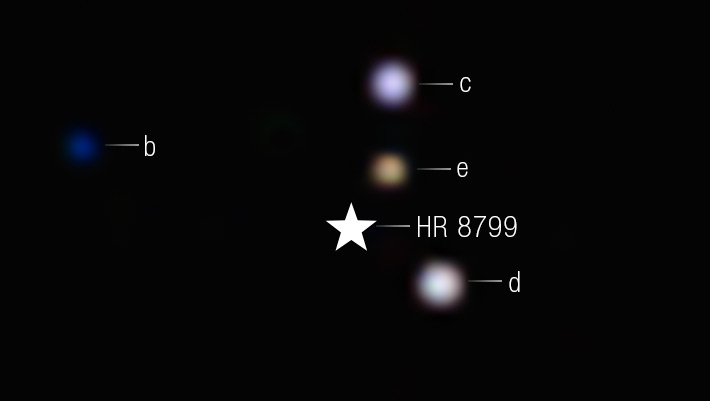Astronomers using the Near-Infrared Camera (NIRCam) onboard the NASA/ESA/CSA James Webb Space Telescope have captured coronagraphic images of the HR 8799 and 51 Eridani planetary systems. These observations have revealed the four known gas-giant planets encircling HR 8799 and one planet around 51 Eridani. They have also revealed that all HR 8799 planets are rich in carbon dioxide.
HR 8799 is a 30-million-year-old star located approximately 129 light-years away in the constellation of Pegasus.
It hosts a massive debris disk and four super-Jupiters: HR 8799b, c, d, and e.
Unlike most exoplanet discoveries, which are inferred from analysis of data, these planets are directly visible through ground-based telescopes.
“By spotting strong carbon dioxide features, we have shown there is a sizable fraction of heavier elements, like carbon, oxygen, and iron, in these planets’ atmospheres,” said Johns Hopkins University astronomer William Balmer.
“Given what we know about the star they orbit, that likely indicates they formed via core accretion, which is an exciting conclusion for planets that we can directly see.”
Still hot from their tumultuous formation, the planets within HR 8799 emit large amounts of infrared light that give scientists valuable data on how they formed.
Giant planets can take shape in two ways: by slowly building solid cores with heavier elements that attract gas, just like the giants in our Solar System, or when particles of gas rapidly coalesce into massive objects from a young star’s cooling disk, which is made mostly of the same kind of material as the star.
The first process is called core accretion, and the second is called disk instability.
Knowing which formation model is more common can give scientists clues to distinguish between the types of planets they find in other systems.
“Our hope with this kind of research is to understand our own Solar System, life, and ourselves in the comparison to other exoplanetary systems, so…
Read the full article here

